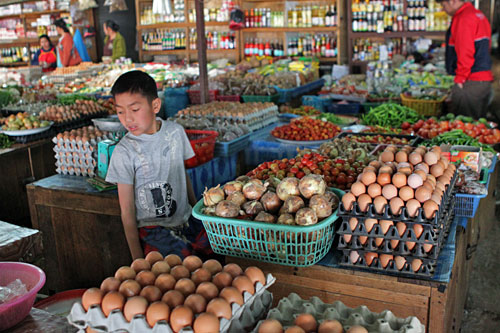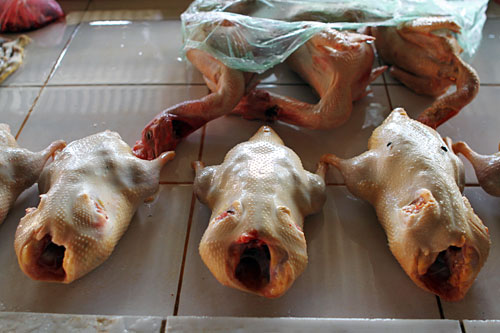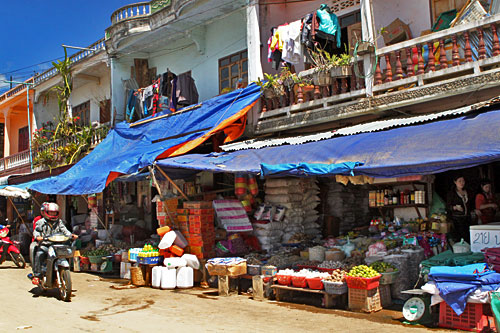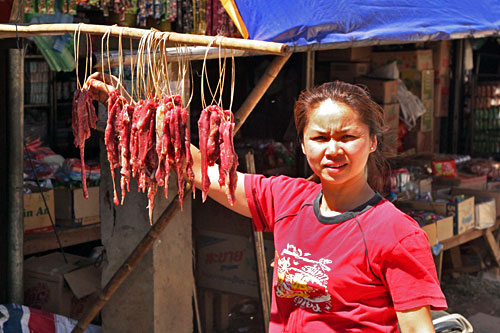Hoping to get a better feel for the local culture during my short stay in Phonsavan, Laos I went in search of a fresh market. I found it just off the main road near the center of town, a large open-air shed where scores of vendors had set up stalls stacked high with fresh produce, baked goods, live fish, dairy products and butchered meats. I wandered around the shadowy interior, taking care not to trip over makeshift wooden steps and cords stretched across aisles to naked bulbs that swung overhead. At the sweets aisle I sampled coconut candy and cakes; in the vegetable aisle I oohed and aahed over royal purple eggplants and three-foot long string beans.


Like dozens of other fresh markets I’ve visited around Asia, the butcher aisle at the Phonsavan market announced itself long before I arrived; I breathed through my nose so as not to retch from the odor of rancid meat and marveled that fly-covered chicken carcases don’t seem to make people sick.


At the end of the final aisle I wandered outside and snooped around a surrounding three-block area chock full of shops that displayed everything from giant bags of rice to metal scythes. Motorcycles roared around a truck where women offloaded enormous cabbages fresh from the farm. Next door, a storekeeper casually hung strips of raw meat in the sun to cure.



Around the corner, giant upside down wicker baskets stood in a row on the dirt shoulder of the road. Curious as to what they contained, I approached a group of locals clustered around one of the chest high baskets. One of the women reached into a hole in the top of the basket and extracted two chickens. She hefted each in turn and gauged its weight before returning it to the basket, repeating the process with each of the captive hens. After fluffing their feathers and examining their anuses (I assume to determine the sex), negotiations began. I didn’t need to understand the language to know that the seller was pointing out attributes of his hens while the buyer was pointing out their deficiencies. Throughout the process, Lao gentility prevailed. Twenty minutes later bartering was still in full swing and neither buyer or seller had raised their voices or exhibited the least bit of frustration.
Unable to wait around to see how negotiations ended, I turned to go and nearly tripped over three strange wicker baskets lying on their sides. Round like a cylinder, the baskets tapered from a wide bottom down to a narrow conical tip. I bent down for a closer inspection and started when I realized they each contained a small hog. So perfectly were the baskets designed that the hogs couldn’t move, yet they endured the indignity of being trapped in wicker corsets without complaint. Having witnessed poultry being examined prior to purchase I wondered about the process involved in buying a pig. Do they check the hog’s teeth? Palpitate the belly? Pull it’s curly tail? Sometimes, not knowing is more fun.

Amazing Photos……. I am also surprise that they don’t get sick from leaving meat out for so long.
Hi Nice to give your blog a perusal especially after a disappointing trip to Bali recently especially after my 1st trip there 20 yrs ago Now looking for a new paradise.
wow poor pigs thats interesting how they conduct business at their outside market
Wow, the colours in those photos…did you use a circular polariser? Looking forward to see some of Laos markets myself this summer. Enjoy and thanks for your blog.
When I first saw the title, I thought this doesn’t sound like Barbara. Despite the occasional gory scene and different standards for handling of animals, I do love the market places – such a central part of so many villages. I am reassured that when an animal is killed that none goes to waste -all being used for cooking or skins or whatever (something that we don’t do so well with in the west). I recall in my early travel days being told that virtually all food that is well cooked and taken straight off the hot plate and given to you is safe to eat. And though I have enough images in my mind of what you describe (flies and meat laying in the sun), I’ve never been made ill from eating street food.
I LOVE Asian markets!!! And yes – they do check out ‘everything’ on a pig. I was at a market once in northern vietnam by the border of china and heard someone ‘inspecting’ a pig for sale. It was the worst noise I’ve ever heard. If you’ve ever heard a pig squeal in terror…you know what I mean. Great photos Barbara!
Oh gosh I would have wanted to rescue the pigs!
Yes, my heart also went out to the pigs, especially since they were baking
in the hot sun and unable to move.
You know, all these markets around the world make me wonder if our food handling and storage laws in the west aren’t just a little too stringent 😀
Hi Andy and Megan: Awesome is the right word for markets; they’re definitely
a shock to the senses. And I wonder the same thing when I see chickens
covered in flies set out on counters under the searing sun for hours on end.
No one ever seems to get Salmonella poisoning in Asia – what’s up with that?
awesome stuff Barbara! sounds just like the markets in Santa Tecla and San Salvador in El Salvador where we recently moved. Coming from the orderly and sedate farmers markets of California to the steamy awesome chaos that is the Latin America mercado is quite awesome. thanks for the awesome imagery